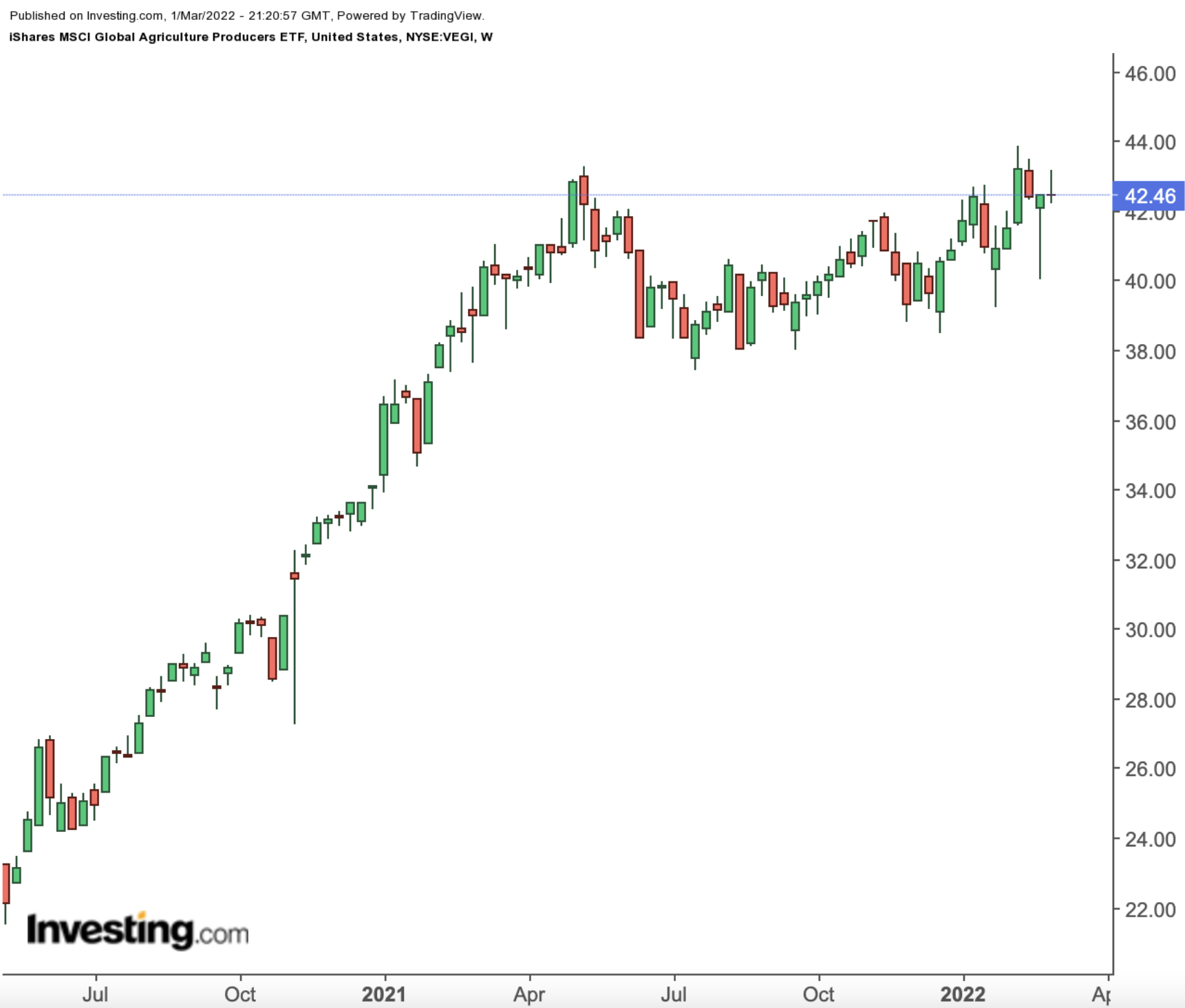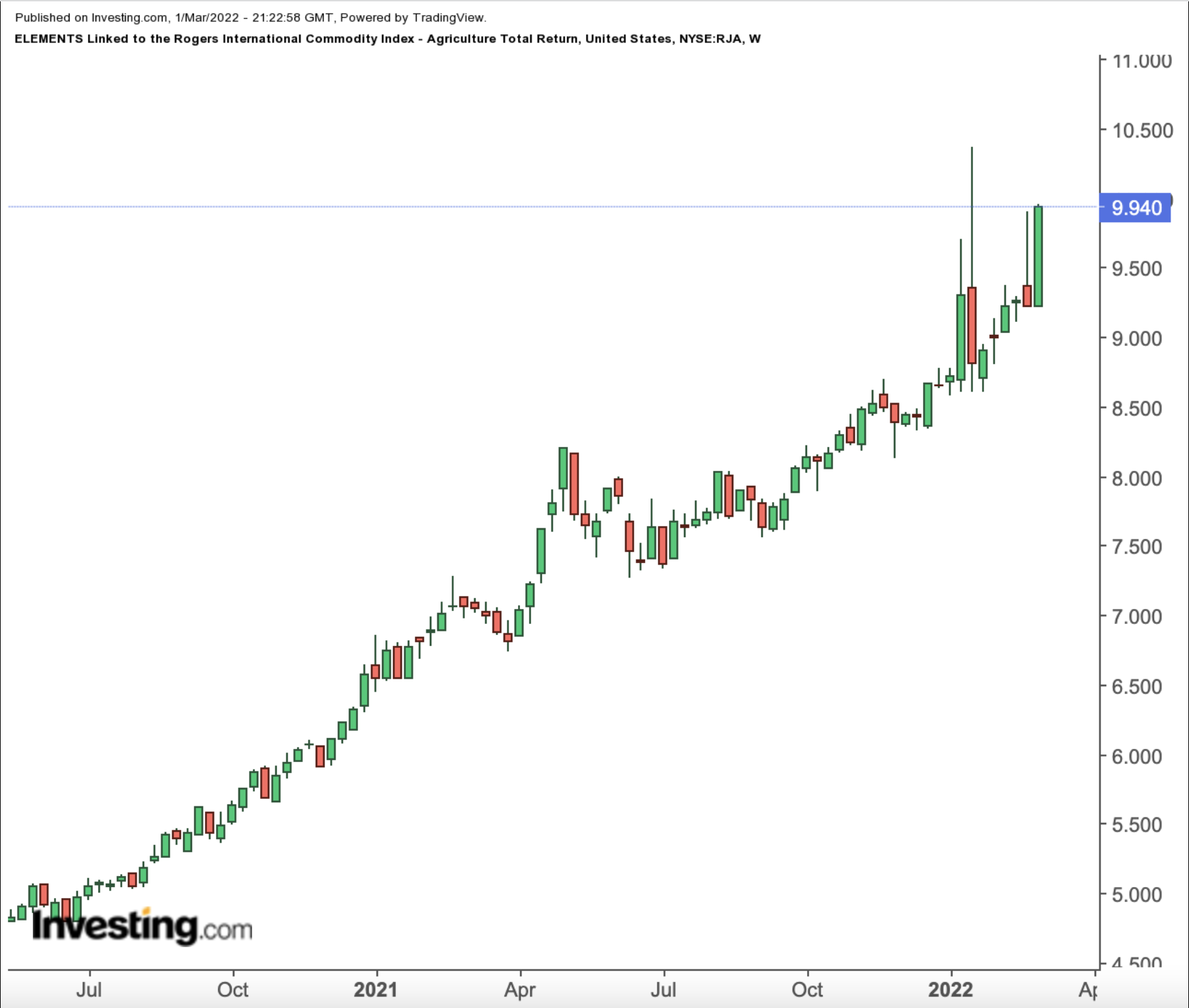Agricultural commodities, stocks, and exchange-traded products (ETPs) have enjoyed significant returns over the past year, as a combination of macro-economic factors provided solid tailwinds for the sector.
Since economies started reopening, inflation, supply chain issues, and recovering fuel demand for ethanol pushed agricultural commodity prices higher. For instance, the broad S&P GSCI Agriculture Index is up over 28% for the period.
But just as analysts started to see the light at the end of the tunnel, with some macro-economic indicators seemingly peaking, the Russian invasion of Ukraine added a whole new set of pressures on agricultural prices.
As a recent report from Gro Intelligence highlights:
“Russia and Ukraine combined to produce 14% of global wheat and supply 29% of all wheat exports. They also contribute 17% of world corn exports.”
S&P Global also points out that the military tension should:
“keep prices of commodities such as sunflower oil, corn, and wheat elevated in the near term.”
We recently covered several funds that could interest readers given the current geopolitical climate—here, here, here, and here. Today’s article introduces two other products.
1. iShares MSCI Global Agriculture Producers ETF
- Current Price: $42.49
- 52-week range: $37.43-$43.88
- Dividend yield: 1.38%
- Expense ratio: 0.39% per year
Our first choice is an exchange-traded fund (ETF), namely, the iShares MSCI Global Agriculture Producers ETF (NYSE:VEGI). It gives access to global firms that produce agricultural chemicals, fertilizers, machinery, and packaged foods. The fund was listed in January 2012.

VEGI, which has 148 holdings, tracks the MSCI ACWI Select Agriculture Producers Investable Market Index. The top 10 holdings account for close to 57% of net assets of $89.8 million.
In terms of the sub-sectors, we see materials (36.35%), consumer staples (34.38%), and industrials (28.83%). Over half the businesses come from the US. Next in line are Canada, Norway, Japan, India, Italy, China, Saudi Arabia, Israel, Malaysia, and others.
Leading holdings in the portfolio include the farming and construction heavy equipment manufacturer Deere & Company (NYSE:DE); Canada-based leading potash producer Nutrien (NYSE:NTR); food processor and commodity heavyweight Archer-Daniels-Midland (NYSE:ADM); Corteva (NYSE:CTVA), which provides crop protection solutions; and Japanese manufacturer of agricultural and construction machinery Kubota (OTC:KUBTY).
In the past 12 months, VEGI returned 10.2 % and saw a record high in recent days. The ETF is also up over 3.9% in 2022.
Trailing P/E and P/B ratios are 16.44x and 2.40x. Interested readers who believe agricultural markets have not yet fully priced in the negative implications of the current military conflict could consider buying VEGI in March.
2. ELEMENTS Linked to the Rogers International Commodity Index - Agriculture Total Return
- Current Price: $9.940
- 52-week range: $6.74-$10.37
- Expense ratio: 0.75% per year
The ELEMENTS Linked to the Rogers International Commodity Index - Agriculture Total Return (NYSE:RJA) is an exchange-traded note (ETN), or unsecured debt security, which we covered in detail here. It gives exposure to agricultural commodities. RJA started trading in October 2007, and net assets stand around $183.5 million.

The ETN, which has 19 holdings, tracks the returns of the Rogers International Commodity Index that is a sub-index of RICI, the Rogers International Commodity Index®—Total ReturnSM. The RICI index was launched in July 1998 by James Rogers, the widely-followed commodities trader.
Around half of RJA is in the leading four commodities: corn (13.60%), wheat (13.60%), cotton (12.03%), and soybeans (10.03%). Then come coffee, live cattle, and soybean oil with a weighting of 5.73% each and other agricultural commodities, such as rapeseed, sugar, rice, orange juice, and milk.
Since the start of the year, RJA has returned over 14.9%. Readers who would like direct commodity exposure (as opposed to investing in companies in the agriculture space) might want to keep RJA on their radar screens.
Geopolitical developments are likely to affect the performance of the commodities in the RJA. Therefore, it could be a short-term tactical trading tool as well. Finally, we should remind readers that all ETNs are subject to credit risk and thus deserve further due diligence.
